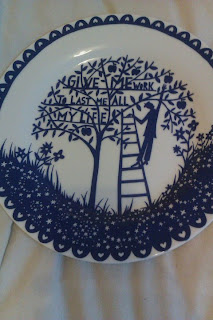Rebecca is an artist based here in Nottingham, her work is based around inverstigating different places and the people that inhabit those places. (Photos are all by the artist herself)
This a a piece called Adaptation, 2010 that Rebecca created and this is how she decribes the piece and the meaning behind this obscure object:
'The Victorian 'language of flowers' was a way of sending a coded message through the use of certain flowers and floral arrangements. Each flower's meaning could be used to express emotions which could not be spoken aloud. The plants in the case all originate in South Africa, and have been chosen for their names and the meanings to create a living letter. The postcards in the drawer offer a key to help you interpret this letter of loss and longing. In the Victorian era, plant collectors brought back strange and rare plants from around the world. They transported the plants in a 'Wardian case', a glass case that creates its own micro-climate. These plants were displayed as rare treasures, as they slowly adapted to their new environment' -Rebecca
I love this idea of a letter made through plants, it's so simple but such a beautiful thing and the case it is transported and displayed in is lovely.
Photos all by Rebecca Beinart
Here are a few more examples of her work...Field Kitchen, 2009
'Field Kitchen is a mobile kitchen on a bicycle trailer that is equipped to cook food foraged from the urban wilds. Field Kitchen makes physical and social interventions into public spaces, offering an invitation to people to smell and taste their botanical locale. The project examines what we can find in our immediate surroundings for sustenance, pleasure and well being – raising questions about our relationship with plants and food, our reliance on imported goods, and lost fields of knowledge.
Field Kitchen was developed with a research & development grant from the Arts Council England and commissioned by Hinterland arts project' -Rebecca
Tea Potential Mobile Experiment, 2008
'The Tea Potential Mobile Experiment is a self-sufficient Tea Party mounted upon a bicycle. The bicycle makes journeys in search of plants to brew up, fuel for the fire, water, and company. The bicycle is ready to unfurl into a tea party at a moments notice. The project quietly asks about our hot-beverage habits, lines of supply, and the alternatives to be found in unexpected places.
Over the summer of 2008, the Tea Bike explored the Tea Potential of areas of Devon, London and Bristol. An archive of teabags records these journeys, made from foraged plants that have been dried and hand-processed. Each one is unique. Each one has a story' -Rebecca
.Anna.


















































